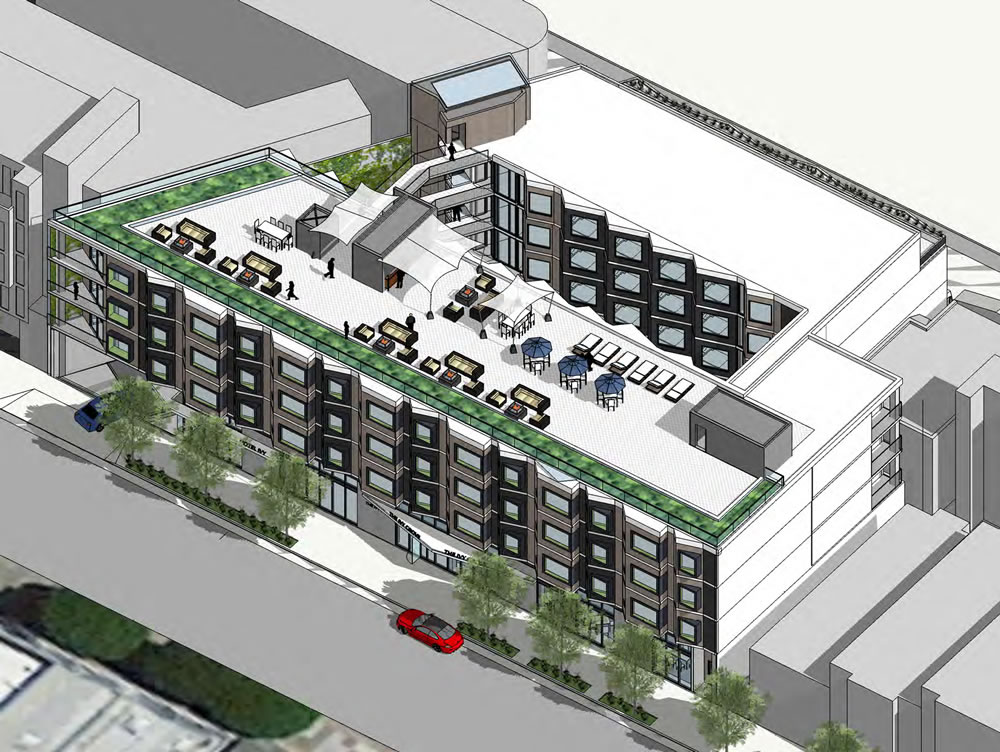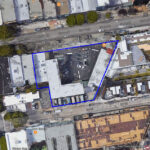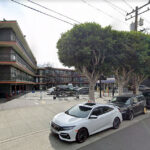Drafted back in 2017, a formal application to move forward with the redevelopment of the Hayes Valley “Days Inn” site at 465 Grove Street, between Gough and Octavia, has been submitted to Planning.
As proposed, the existing 41-room hotel would be razed, along with the adjacent duplex at 477 Grove Street, and a new 4-story, 105-room boutique hotel would rise up to 45 feet in height across the site, along with two replacement residential units, a new restaurant/retail space, and a basement garage for 20 cars.
We’ll keep you posted and plugged-in as the plans progress.



This is one of the last remaining large lots that’s due for redevelopment in the core of Hayes Valley. Small infill projects will continue of course, but most of the work is now complete. Bravo to everyone involved as Hayes Valley has transformed dramatically for the better in the last 20 years since the freeway was first demolished.
I live in HV and agree with the sentiment that much positive change has occurred since the freeway came down.
But this site is NOT “one of the last remaining large lots that’s due for development”. First of all, it is not an undeveloped lot, as it already has a functioning business and habitable buildings. The Proxy site and the adjacent lot where the Beirgarden was located ARE the largest “remaining large lots that’s due for development”. Both of these sites are destined to be developed as housing. The re-development of the Day’s Inn site is not in-fill along the old freeway path, as the motel had long operated within the shadow of the freeway.
You’re taking my comment far too literally. This is a large site in Hayes Valley which is mostly a surface parking lot. I’m implying that its overdue for development / underutilized in its current form, along with the other lots you mentioned. That’s all. Happy Friday.
As another Hayes valley resident, I’d argue that the use at Biergarten and Proxy is dramatically more intense than the use an extremely antiquated low end hotel. They’re also fundamentally small parcels with major challenges, especially for the proxy site which potentially has no street access.
Hayes valley is better in the ways you mentioned, but rampant crime, open air drug use and homelessness is worse than every in Hayes Valley. I know at least 2 people who recently moved due to home break-ins and encampments in front of their condos. Hopefully the TL crackdown will work, but a possible side effect is that more gets pushed to areas like hayes valley
Yes, unfortunately, Hayes Valley is within the immediate radius of the Tenderloin / SOMA / Civic Center nexus of issues, so it sees problems, too. Admittedly, I wasn’t here in the 80’s, 90’s etc but I’ve been told that it’s generally nicer than it was then, even regarding crime and drug use.
Then why are you making these pronouncements as an expert when you weren’t even here? Hayes Valley was funky and cool and what’s replaced it is fine, though overcrowded and already fraying around the edges due to the city’s habit of bad upkeep. The sidewalks are filthy, the plantscape looks ratty, and traffic as always is bizarre it sits in the middle of the city’s great freeway folly, the Market St ramp approach. Powell’s fried chicken, cool 80’s alt hair salons and a Black Muslim Bakery that forced children to serve customers was all part of the mix back in the day.
Hayes Valley is artificially isolated due to awful planning department decisions. It could have made a great contiguous corridor on across Market all the way to Showplace Square. And there are great developable lots all through that SOMA side should the city ever wake up and extend the Hayes Valley zoning across Market and remove that ridiculous freeway all the way to Hospital curve.
I’ve read many articles and accounts of Hayes Valley back then. Police data tells a similar story. Violent crime and prostitution were extremely common in the area. So was crack usage. I’m sure the homeless problem wasn’t as bad, but Hayes Valley now sounds quite a bit nicer.
Hayes Valley was indeed pretty dismal back in the freeway overpass days. There were just a few retail businesses open and very little pedestrian traffic. Crime wasn’t as bad as the worst parts of the Tenderloin today, but pretty close. When a friend just out of college bought a 3 flat unit on Hayes with a couple of other partners, I thought he was quite brave despite the very low cost (by today’s metrics) of the building. Turns out that they were on to something and their building is now worth millions. Hayes is vastly improved and has gone from a run down and nearly vacant place to a lively commercial center. Like Valencia, one of the city’s big successes.
I miss the Central Freeway that spilled onto Fell. Traffic was so much more fluid / less gridlock then. Octavia/ Market is a clusterf— and a deathtrap for cyclists and pedestrians. It seems like an area planned by committee rather than those that actually use it.
I wouldn’t go that far, but the Octavia-Market boulevard has as much visual interest as a freeway, and full of cars anxious to be speeding west along Fell or south onto the freeway. I usually walk or bicycle to Market along Laguna. Wonder how Biden’s plan to tear down freeways that have bisected neighborhoods will work out. Does anyone have any examples of a successful restoration?
The Embarcadero (and Hayes Valley, as well as 880 through West Oakland – which was relocated but not really torn down).
Right. Octavia/ Market – a.k.a. the Gaza Strip
“Shuttered”?
When did that happen? I thought they were using it for homeless or some other emergency housing, no?
Shuttered in its service as a tourist hotel, the wording of which has since been changed above.
Ah. I was out of town when the clientele changed and never looked into whether they’d given up being a hotel (despite always being full) or if they were just under contract with the City for some period of time.
I assume any replacement “boutique hotel” would be considerably more expensive, which is a shame.
This looks great. I’m excited to see this get built.
The owner/project proponent has been sitting on this application for going on five years and you’re excited to see it get built? Please do go ahead and hold your breath while you’re waiting for them to break ground.
I miss the little sushi restaurant that used to occupy that tiny round annex building. Midori Mushi was the name.
Clearly there’s overwhelming demand for travel and hotels…. #entitleandsell.
What’s the buyer profile for a hotel entitlement, in your mind?
Someone who wants to land bank a future hotel development and knows how to construct big projects in urban settings. I don’t think there is booming demand generally.
citizenM by union square opened during the pandemic, it wouldn’t be the only COVID era hotel project in town.
Do they really need to tear the whole structure down? It seems a real waste. Wouldn’t it be a more cost effective & efficient use of resources to just upgrade the existing building? In Los Angeles, a lot of the older 50’s & 60’s style hotels are being remodeled with great outcomes. The Mayumi in Culver City is a great example.
Have you seen it? Clearly it is not salvageable as a vintage property. SF seems to have a hard time doing those restorations well. Look at Beck’s Motor Lodge.
As an architect in the area (designer of Black Mass Linden Street Apartments (SPARCHS) — I have to ask — Why is this building design so mediocre? The public deserves better. A few angular bay windows all looking the same just doesn’t cut it. If it was an amazing design that supported the community with affordable housing and a variety of social spaces — people wouldn’t be complaining…
Because it’s a budget hotel. It’s not the Parc 55. It’s not a Mission Housing project. Are people not allowed to own and operate hotels anymore?
Why would a hotel developer be required to build affordable housing units? We already require private residential developers to build affordable housing units or pay an in-lieu fee (except for very small projects) and we have public housing. I do not think there would be a legal basis to extort a hotel developer to fund affordable housing units on a property that already is zoned for and had an operating hotel for many years. And, look at what is on the site now–a rundown, shuttered hotel, so anything would be an improvement. Not every building needs to be a landmark architectural design.
I am not saying the building design couldn’t be improved through some tweaks, but I think there is both a legal and practical limit to what you can ask a developer to foot the bill for.
I agree it’s an ugly building. Also, I just checked out your building and it’s super cool! But I don’t understand where you’re coming from on: design + public spaces + affordable housing = no neighborhood opposition.
There is always opposition, regardless of the affordable housing allowance, and in particular when the designs are interesting. As an architect, surely you must be aware of this, but if you really don’t believe me, go look at some back issues of the Noe Valley Voice, where they complain incessantly about there being too many “modern” buildings in the neighborhood.
SF has way too many choke points to kill development and it has made the city unaffordable and unlivable. Were I dictator for a day, I’d make a mile-high affordable housing tower on Broadway in the shape of a tumescent penis complete with glans and geodesic testicles, just to piss off all the NIMBYs who have ruined the city.
Architectural design debates aside, here’s a fun read about the lone palm tree that resides on the property.
Cool piece. Thanks!
Because the palm is within ten feet of the public right-of-way and is greater than 20 feet in height, it is considered a significant tree under San Francisco statute 20 feet????
I’m surprised this reg doesn’t attract more comment.
Is there a way to view the planning app or see the applicant’s name online?